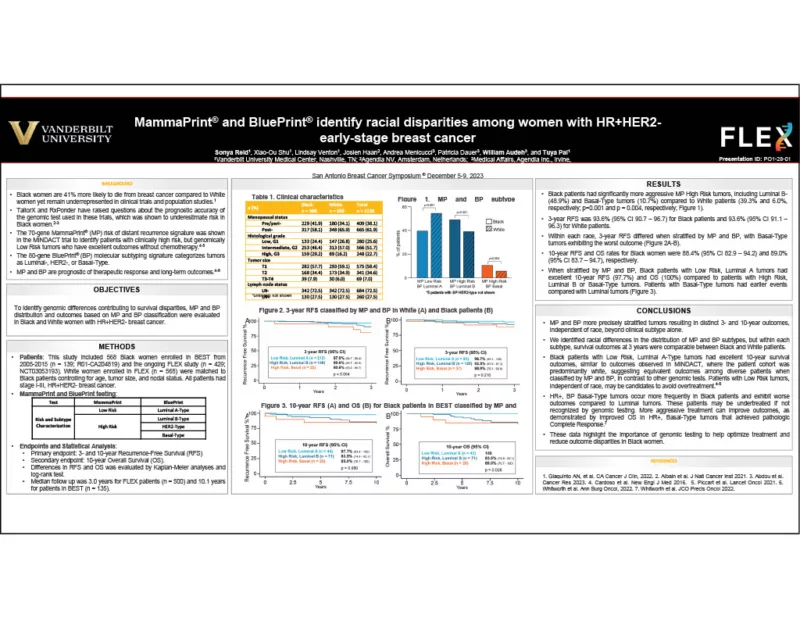Title: MammaPrint and BluePrint identify racial disparities among women with HR+HER2- early-stage breast cancer
Publication: SABCS 2023, PO1-08-01
Authors
Sonya Reid, Xiao-Ou Shu, Lindsay Venton, Josien Haan, Andrea Menicucci, Patricia Dauer, William Audeh, Tuya Pal
Background
Black women are 41% more likely to die from breast cancer compared to White women yet remain underrepresented in clinical trials and population studies. We have previously shown a higher proportion of Black women with HR+HER2- tumors further classify as Basal-Type compared with White women, using BluePrint molecular subtyping. Other studies have demonstrated higher 3-year recurrence rates in patients with BluePrint Basal-Type tumors compared to Luminal-Type. To determine whether the increased frequency of HR+/Basal-Type tumors impacts long-term outcomes in this cohort, we compared 3-year outcomes with BluePrint and the risk of distant recurrence signature, MammaPrint (MP), between Black and White women with HR+HER2- breast cancer. We also evaluated the association of MP and BluePrint with 10-year outcomes in a subset of Black women.
Methods
This study included 635 women with stage I-III, HR+HER2- breast cancer, of whom, 135 Black women were enrolled in the BEST study between 2005-2015 (R01-CA204819), and 120 Black women and 380 White women are enrolled in the ongoing FLEX study (NCT03053193). Each patient had MP and BluePrint testing. MP classifies tumors as having a Low Risk or High Risk of distant recurrence. BluePrint categorizes tumors as Luminal-Type, HER2-Type, or Basal-Type. Together, MP and BluePrint further stratify Luminal tumors into Luminal A-Type (MP Low Risk) and Luminal B-Type (MP High Risk). Recurrence-free survival (RFS) was the primary endpoint. Overall survival (OS) at 10 years was the secondary endpoint for those with long-term follow up. RFS and OS are defined per STEEP criteria. Survival curves were estimated using Kaplan-Meier analyses, and significance between groups was determined using log-rank test.
Results
Among all patients, 14.5% of Black women had BluePrint Basal-Type tumors compared to 5.8% of White women (p<0.001). Median follow up was 3.0 years for patients in FLEX, and 10.1 years for patients in BEST. The unstratified 3-year RFS was 93.6% (95% CI 90.7 – 96.7) for Black patients and 93.6% (95% CI 91.1 – 96.3) for White patients. When further stratified by MP and BluePrint, 3-year RFS for patients with HR+HER2- tumors significantly differed (p=0.002). Patients with HR+/Luminal A tumors exhibited the best 3-year RFS (96.9%; 95% CI 95.0 – 98.9), followed by HR+/Luminal B tumors (91.6%; 95% CI 88.2 – 95.1), and HR+/Basal tumors (85.8%; 95% CI 77.2 – 95.5). For a subset of patients with 10-year follow up, we evaluated the association of MP and BluePrint with RFS (n=135) and OS (n=134). The unstratified 10-year RFS and OS rates for Black women were 88.4% (95% CI 82.9 – 94.2) and 89.0% (95% CI 83.7 – 94.7), respectively. When stratified by MP and BluePrint, Black patients with HR+/Luminal A tumors had a 10-year RFS of 97.7% (95% CI 93.4 – 100), versus 83.5% (95% CI 74.8 – 93.1) for patients with HR+/Luminal B, and 85.0% (95% CI 70.7 – 100) for patients with HR+/Basal tumors (p=0.080). Similarly, Black patients with HR+/Luminal A tumors exhibited excellent 10-year OS (100%), whereas OS for patients with HR+/Luminal B (83.5%; 95% CI 74.8 – 93.1) and HR+/Basal tumors (85.0%; 95% CI 70.7 – 100) were significantly lower (p=0.026).
Conclusions
Survival outcomes at 3 years were comparable between Black and White patients. MP and BluePrint more precisely stratified tumors resulting in distinct 3- and 10-year outcomes, independent of race, beyond clinical subtype alone. Additionally, the subset of Black patients with Low Risk, Luminal A-Type tumors had excellent 10-year survival outcomes. Patients with HR+ tumors that further classify as Basal-Type, which occur more frequently in Black patients, have worse outcomes compared to Luminal A-Type tumors, and may warrant more aggressive treatment. These data highlight the importance of genomic testing to help optimize treatments and reduce outcome disparities in Black women.



